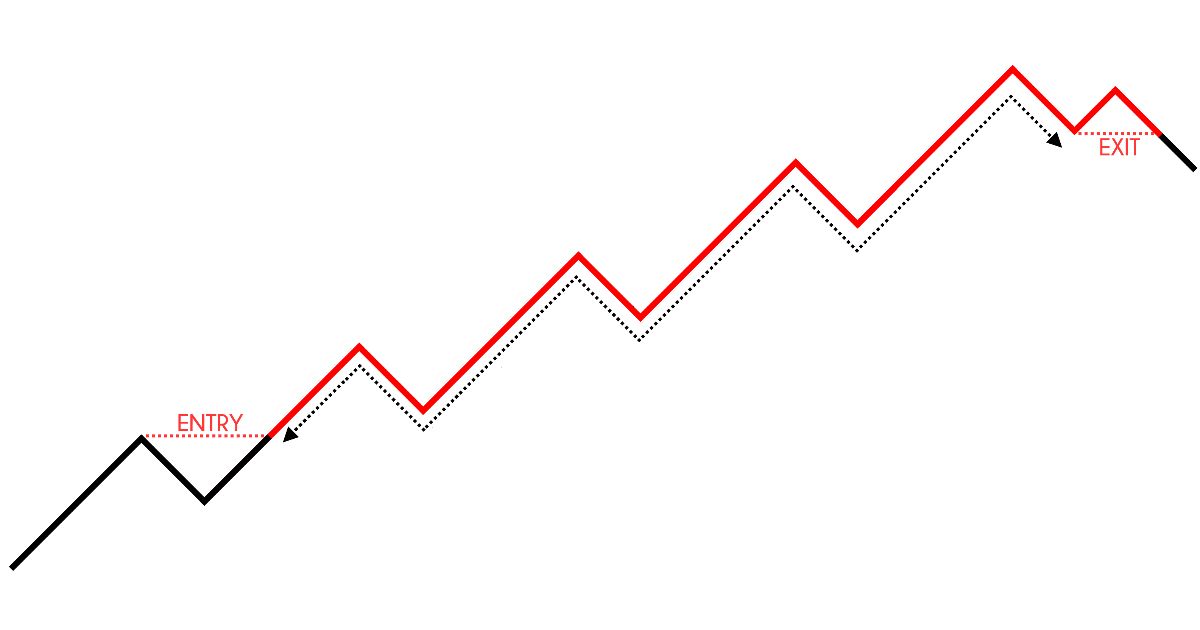Introduction
Position trading is a popular strategy used in the financial markets, attracting both beginners and experienced traders alike. Unlike day trading or swing trading that focus on short-term price movements, position trading takes a longer-term approach, aiming to capture larger trends and profits. In this article, we will delve into the concept of position trading, discussing its benefits, drawbacks, and how to get started with this strategy.
Position trading involves holding a position for an extended period, ranging from several weeks to months or even years. Traders who employ this strategy are less concerned with short-term fluctuations and noise in the market, instead focusing on capturing and profiting from substantial price movements. The goal is to identify and ride long-term trends, whether the market is trending up or down.
One of the main benefits of position trading is that it requires less time commitment compared to day trading or swing trading. Position traders do not have to monitor the markets constantly or make frequent trades, allowing them to maintain their regular jobs or other obligations. This makes position trading an appealing strategy for individuals who cannot dedicate a significant amount of time to active trading.
Another advantage of position trading is the potential for significant profits. By capturing substantial price movements of underlying assets, position traders have the opportunity to generate substantial returns. Since position trades are held for an extended period, they can ride out short-term market volatility and focus on the overall trend, aiming for larger gains.
However, it is important to note that position trading is not without its drawbacks. One of the key challenges is the requirement for patience and discipline. Position trades often involve longer holding periods, which means traders need to be patient and resist the temptation to exit prematurely or make impulsive decisions based on short-term market fluctuations.
Additionally, position traders need to have a solid understanding of fundamental analysis and technical analysis. Fundamental analysis involves analyzing the financial health, competitive landscape, and overall market conditions of the asset being traded. Technical analysis, on the other hand, involves studying price charts, indicators, and patterns to identify potential entry and exit points.
In the next sections of this article, we will explore how to get started with position trading, including choosing the right time frame, identifying and analyzing trends, setting entry and exit points, managing risk and capital, and understanding different position trading strategies. We will also provide case studies of successful position trades and offer tips for successful position trading.
Now that we have covered the basics, let’s dive into the details of position trading and equip ourselves with the necessary knowledge and skills to embark on this trading strategy.
What is Position Trading?
Position trading is a trading strategy that involves taking longer-term positions in the financial markets with the aim of capturing and profiting from significant price movements. Unlike day trading or swing trading, which focus on short-term price fluctuations, position trading is more patient and looks to capture trends that can last for weeks, months, or even years.
The core idea behind position trading is to identify and ride major market trends. Traders who employ this strategy aim to enter a position at the beginning of a trend and hold it until the trend shows signs of reversal or exhaustion. The goal is to capture substantial gains from the overall movement of the market or a specific asset.
Position traders usually rely on both fundamental and technical analysis to identify potential opportunities. Fundamental analysis involves assessing the financial health, industry dynamics, and overall market conditions of a particular asset. This analysis helps position traders determine whether an asset is undervalued or overvalued and can provide insights into potential long-term trends.
Technical analysis is also a crucial aspect of position trading. Traders use technical indicators, price charts, and patterns to identify entry and exit points for their positions. Various tools, such as moving averages, trendlines, and oscillators, are used to gauge the strength and direction of a trend. By combining fundamental and technical analysis, position traders can make more informed decisions and increase their chances of success.
One key characteristic of position trading is the longer holding period. Position traders are willing to withstand short-term market volatility and fluctuations to ride out the overall trend. This requires a high level of patience and discipline, as position traders may experience periods of temporary losses or sideways movements before the trend resumes.
Position trading can be applied to various financial markets, including stocks, forex, commodities, and cryptocurrencies. The strategy is adaptable and allows traders to take advantage of both bullish and bearish trends. However, it’s important to note that position trading may not be suitable for all traders. It requires a long-term perspective, a commitment to ongoing analysis, and a tolerance for potential drawdowns.
In summary, position trading is a trading strategy that involves taking longer-term positions in order to capture significant price movements. It is based on identifying and riding major market trends and requires a combination of fundamental and technical analysis. Position traders need to be patient and disciplined, willing to withstand short-term market fluctuations in order to profit from the overall trend. While position trading may not be suitable for every trader, it offers the potential for substantial gains for those who are willing to commit to a longer-term approach.
Benefits of Position Trading
Position trading offers several benefits that can appeal to traders looking for a more long-term approach to the financial markets. Let’s explore some of the key advantages of position trading:
1. Less Time Commitment: Unlike day trading or swing trading, position trading requires less time commitment. Position traders do not need to monitor the markets constantly or make frequent trades. This is particularly appealing for individuals who have other obligations or cannot dedicate a significant amount of time to active trading.
2. Potential for Significant Profits: Position trading provides the opportunity for substantial profits. By capturing major price movements and riding long-term trends, position traders can maximize their gains. Since position trades are held for an extended period, traders can ride out short-term market fluctuations and focus on the overall direction of the trend.
3. Reduced Stress and Emotion: Short-term trading strategies can be stressful and emotionally demanding. Position trading, on the other hand, allows traders to maintain a more relaxed approach. By taking a longer-term perspective, position traders are less affected by daily market noise or temporary price fluctuations. This can help reduce stress and make trading decisions more logical and less influenced by emotions.
4. Flexibility in Trading Capital: Position trading does not require a large amount of capital to get started. Traders can enter positions with smaller amounts of money and still have the potential to achieve significant returns. This flexibility makes position trading accessible to a wide range of traders, including those with limited trading capital.
5. Opportunity to Ride Major Trends: Position traders aim to capture major trends in the market. By staying in positions for longer periods, they have the chance to profit from substantial market movements. Whether the market is trending up or down, position traders can take advantage of these trends and potentially generate substantial returns.
6. Diversification of Trading Strategies: Position trading can complement other trading strategies and help diversify a trader’s portfolio. Traders who already engage in short-term trading or swing trading can benefit from incorporating position trades into their overall strategy. This diversification can help spread risk and potentially increase overall trading profits.
It’s important to note that while position trading offers these benefits, it is not without certain drawbacks. Position traders need to exercise patience, maintain a disciplined approach, and be prepared for potential drawdowns. It’s crucial to conduct thorough research, analyze market trends, and manage risk effectively.
In the next sections, we’ll delve deeper into how to get started with position trading, including choosing the right time frame, identifying and analyzing trends, setting entry and exit points, managing risk and capital, and exploring different position trading strategies.
Drawbacks of Position Trading
While position trading offers several benefits, it is important to understand and consider the potential drawbacks before implementing this strategy. Let’s discuss some of the main drawbacks of position trading:
1. Longer Holding Periods: One of the key challenges of position trading is the longer holding periods involved. Position traders hold their positions for weeks, months, or even years, aiming to capture significant trends. This requires patience and discipline to stay committed to the trade during periods of temporary losses or sideways market movements.
2. Potential for Drawdowns: Position traders need to be prepared for potential drawdowns in their trades. As the market moves in waves, there may be times when the price temporarily goes against the expected trend. These drawdowns can test a trader’s patience and may require additional analysis and adjustments to the position if the overall trend remains intact.
3. Limited Trade Frequency: Position trading involves fewer trades compared to shorter-term trading strategies like day trading or swing trading. This reduced trade frequency means that position traders may have limited opportunities to enter and exit trades, potentially missing out on shorter-term profit opportunities. Traders who prefer more action and frequent trading may find position trading less exciting.
4. Increased Exposure to Market Risk: Holding positions for extended periods exposes position traders to market risks. Market conditions and trends can change over time, and unexpected events or news can have a significant impact on the positions held. Position traders need to stay vigilant and continuously assess market conditions to manage and adjust their trades accordingly.
5. Requires Strong Analytical Skills: Position trading requires a solid understanding of fundamental and technical analysis. Traders need to analyze market trends, identify potential entry and exit points, and conduct thorough research on the assets they are trading. This level of analysis and research may pose a challenge for traders who are less experienced or have limited knowledge of these analytical techniques.
6. Emotional Challenges: While position trading can help reduce stress compared to shorter-term trading strategies, it still requires emotional discipline. Position traders must resist the temptation to exit positions too early or make impulsive decisions based on short-term market fluctuations. Maintaining a rational and patient mindset is crucial to avoid making emotional and detrimental trading decisions.
Understanding the potential drawbacks of position trading allows traders to make informed decisions and develop strategies to mitigate these challenges. It is important to conduct thorough research, continuously monitor the market, and adapt strategies as needed to increase the chances of successful position trading.
In the next sections, we will explore how to get started with position trading, including choosing the right time frame, identifying and analyzing trends, setting entry and exit points, managing risk and capital, and exploring different position trading strategies.
How to Get Started with Position Trading
If you’re interested in position trading, here are some steps to help you get started:
1. Develop a Trading Plan: Before diving into position trading, it’s essential to develop a well-defined trading plan. Determine your financial goals, risk tolerance, and time commitment. Outline your preferred trading instruments and markets. A trading plan will serve as your roadmap, guiding your decisions and actions throughout your position trading journey.
2. Choose the Right Time Frame: Position trading involves holding positions for extended periods. Choose a time frame that aligns with your trading goals and lifestyle. Longer time frames, such as weekly or monthly charts, are commonly used in position trading. These charts provide a broader view of market trends and make it easier to identify and analyze long-term trends.
3. Identify and Analyze Market Trends: Conduct thorough market analysis to identify potential trends. Use both fundamental and technical analysis to assess the health of the market and the asset you want to trade. Fundamental analysis involves researching the financials, news, and overall market conditions. Technical analysis involves studying price charts, indicators, and patterns to identify potential entry and exit points.
4. Set Entry and Exit Points: Establish clear entry and exit points for your position trades. Based on your analysis, identify key support and resistance levels, trendlines, or moving averages that can act as potential entry or exit points. By setting these points in advance, you can enter trades at favorable prices and exit with profit targets in mind.
5. Manage Risk and Capital: Risk management is crucial in position trading. Determine the amount of capital you are willing to risk per trade and set appropriate position sizes accordingly. Consider using stop-loss orders to limit potential losses in case the trade goes against you. Regularly reassess and adjust risk management strategies as your account and positions evolve.
6. Monitor and Adjust Your Positions: Position trading requires ongoing monitoring and analysis. Stay updated on market conditions and news that may impact your positions. As the trade progresses, regularly review your analysis and adjust your positions if necessary. Be prepared to make timely decisions based on changing market dynamics.
7. Be Patient and Disciplined: Position trading requires patience and discipline, as positions are held for longer periods. Resist the urge to make impulsive decisions based on short-term market fluctuations. Stick to your trading plan and strategy, allowing the overall trend to play out.
8. Continuously Learn and Adapt: Position trading is a continuous learning process. Stay informed about new trading strategies, market trends, and developments in the financial markets. Regularly evaluate and adapt your trading plan, strategy, and risk management techniques as needed.
Remember, position trading is a long-term strategy that requires dedication, analysis, and discipline. It may take time and practice to become proficient in position trading. Be prepared for both successes and failures, and use each experience as an opportunity to learn and improve your trading skills.
In the next sections, we will delve deeper into choosing the right time frame for position trading, identifying and analyzing trends, setting entry and exit points, managing risk and capital, and exploring different position trading strategies.
Choosing the Right Time Frame for Position Trading
The time frame you choose for position trading is a crucial factor in your trading success. It determines the length of time you hold your positions and impacts the level of analysis required. Here are some considerations to help you choose the right time frame for position trading:
1. Define Your Trading Goals: Begin by defining your trading goals. Are you looking for shorter-term gains or aiming for long-term wealth accumulation? Your goals will influence the time frame you choose. If you have a long-term perspective and are willing to hold positions for months or even years, then a higher time frame like weekly or monthly charts may be appropriate. On the other hand, if you are seeking shorter-term gains, you might consider lower time frames like daily or four-hour charts.
2. Assess Available Time: Consider the amount of time you can dedicate to position trading. If you have limited time availability, a higher time frame might be more suitable as it requires less frequent monitoring and analysis. Conversely, if you have more time and can commit to consistent analysis and monitoring, you might opt for a lower time frame that offers more trading opportunities.
3. Identify the Targeted Trends: Analyze the market and identify the trends you want to capitalize on. Higher time frames provide a broader view of the market and help identify long-term trends. Lower time frames, on the other hand, offer insights into shorter-term market dynamics. Choose the time frame that aligns with the trends you aim to capture.
4. Consider Volatility: Different time frames exhibit different levels of volatility. Higher time frames tend to have lower volatility, which means less frequent and smaller price fluctuations. Lower time frames can be more volatile, with higher price fluctuations, offering more frequent trading opportunities. Consider your risk tolerance and preference for volatility when selecting a time frame.
5. Match Your Trading Style: Your trading style also plays a role in determining the appropriate time frame. If you prefer a more relaxed and patient approach, a higher time frame may suit you better. On the other hand, if you enjoy more active trading and can handle shorter-term price movements, a lower time frame might be more appealing.
6. Combine Multiple Time Frames: Consider combining multiple time frames to gain a comprehensive perspective. This approach allows you to analyze long-term trends on higher time frames and fine-tune entry and exit points using lower time frames. By using multiple time frames, you can benefit from both the broader trend and the smaller intraday or intraweek price movements.
Remember, there is no one-size-fits-all solution when it comes to choosing the right time frame for position trading. It is a personal choice that depends on your goals, availability, risk tolerance, and trading style. It’s also important to regularly reassess and adapt your time frame as market conditions and trends change.
In the following sections, we will delve deeper into identifying and analyzing trends, setting entry and exit points, and managing risk and capital in position trading. These elements, coupled with the right time frame, will help you make informed trading decisions and maximize your chances of success.
Identifying and Analyzing Trends in Position Trading
Identifying and analyzing trends is a core component of successful position trading. By understanding market trends, you can determine the direction an asset is moving in and position yourself to capture potential profits. Here are some key factors to consider when identifying and analyzing trends in position trading:
1. Utilize Technical Analysis: Technical analysis is a valuable tool in identifying and analyzing trends. It involves studying price charts, indicators, and patterns to gain insights into market behavior. Common technical indicators used in trend analysis include moving averages, trendlines, and oscillators. By examining these indicators, you can identify whether a market is trending upwards, downwards, or moving in a sideways pattern.
2. Define Trend Strength: Assessing the strength of a trend is crucial before entering a position trade. Trends can range from weak to strong. A strong trend is characterized by consistent price movement in one direction with little to no retracements. Weak trends show more frequent retracements and smaller price movements. Evaluating trend strength allows you to gauge the potential profitability and stability of a trend.
3. Multiple Time Frame Analysis: Analyzing trends across multiple time frames is essential for a comprehensive view. Higher time frames, such as weekly or monthly charts, provide a broader perspective on the overall trend. Lower time frames, such as daily or hourly charts, offer insights into shorter-term price movements. By comparing trends across different time frames, you can confirm the consistency and robustness of a trend.
4. Consider Support and Resistance Levels: Support and resistance levels are important tools in trend analysis. Support levels are areas where the price is expected to find buying interest and potentially reverse its decline. Resistance levels, on the other hand, are areas where the price is likely to face selling pressure and potentially reverse its rise. Identifying these levels helps determine potential entry and exit points for position trades.
5. Fundamental Analysis: While technical analysis is valuable, don’t overlook the importance of fundamental analysis. Understanding the underlying fundamentals of an asset or market can provide insights into long-term trends. Factors such as economic indicators, company earnings, geopolitical events, and industry trends can all impact market trends. Combine fundamental analysis with technical analysis to form a holistic view of the market.
6. Track Market Sentiment: Market sentiment refers to the overall feeling or attitude of traders and investors towards a particular market or asset. It can influence the direction and strength of a trend. Monitoring market sentiment through news, social media, and forums can help validate a trend or alert you to potential shifts in sentiment that may impact your position trades.
Remember, trend analysis is not foolproof, and there is always a degree of uncertainty in the markets. It is important to regularly reassess and update your analysis as market conditions change. By staying vigilant and adapting to evolving trends, you can increase your chances of identifying profitable opportunities in position trading.
In the next sections, we will explore setting entry and exit points for position trades, managing risk and capital, and exploring different position trading strategies. These elements, combined with an understanding of trend analysis, will help you execute successful position trades.
Setting Entry and Exit Points for Position Trades
Setting precise entry and exit points is crucial for successful position trading. These points determine when to enter a trade to capture a trend’s potential and when to exit to lock in profits or cut losses. Here are some strategies to consider when setting entry and exit points for your position trades:
1. Confirmation from Technical Indicators: Utilize technical indicators to confirm potential entry and exit points. Popular indicators like moving averages, trendlines, and oscillators can provide valuable insights. For example, a moving average crossover, where a shorter-term moving average crosses above a longer-term moving average, can signal a bullish entry point. Conversely, a breakdown of a support level may indicate an exit point.
2. Breakout and Pullback Strategy: Consider using a breakout and pullback strategy to time your entry and exit points. This strategy involves entering a trade when the price breaks out of a key resistance level or a significant trendline. After the breakout, wait for a pullback, or a temporary retracement of the price, to enter the trade. This strategy allows you to enter at a favorable price and minimize the risk of false breakouts.
3. Support and Resistance Levels: Identify support and resistance levels to determine potential entry and exit points. When the price approaches a support level, it may provide a buying opportunity. Conversely, when the price reaches a resistance level, it may be a suitable exit point. Keep in mind that support and resistance levels should be confirmed by other technical indicators or patterns to increase their reliability.
4. Use Trailing Stop Orders: Consider implementing trailing stop orders to protect your profits and limit potential losses. A trailing stop order automatically adjusts the stop-loss level as the price moves in your favor. This allows you to lock in profits if the price reverses, while still allowing for potential upside if the trend continues. Trailing stop orders are especially useful for position traders who want to capture larger trend movements while managing risk.
5. Monitor Price and Volume: Pay attention to the price and volume patterns when setting entry and exit points. A surge in volume along with a price breakout or breakdown can provide additional confirmation for entry or exit decisions. Volume can indicate the strength of a move and whether there is sufficient market participation to sustain the trend.
6. Consider Fundamental Factors: In addition to technical indicators, consider fundamental factors when setting entry and exit points. For example, positive earnings reports, industry news, or economic data releases can impact the price movement of an asset. Incorporate relevant fundamental factors into your analysis to make informed decisions about entry and exit points.
Remember, setting entry and exit points is a dynamic process that requires ongoing analysis and adjustment. Market conditions and trends can change, so it’s important to monitor your positions and adapt as necessary. By combining technical analysis, understanding key levels, and incorporating other relevant factors, you can enhance your ability to set accurate entry and exit points for your position trades.
In the following sections, we will explore managing risk and capital in position trading and discuss different position trading strategies. These elements, combined with effective entry and exit point determination, will help you navigate the world of position trading with confidence.
Managing Risk and Capital in Position Trading
Managing risk and capital is a critical aspect of successful position trading. It involves implementing strategies to protect your trading capital, minimize potential losses, and optimize risk-reward ratios. Here are some key practices to consider when managing risk and capital in position trading:
1. Establish Risk Management Rules: Define your risk tolerance and establish clear risk management rules. Determine the maximum percentage of your trading capital that you are willing to risk per trade. Many successful traders limit their risk to 1-2% of their trading capital per trade. By adhering to these rules, you can prevent significant drawdowns and protect your capital.
2. Use Stop-Loss Orders: Place stop-loss orders to limit potential losses. A stop-loss order is an instruction to sell a position if the price reaches a predetermined level. It helps you exit a trade before losses become too substantial. Set your stop-loss level based on your analysis and risk management rules. Ensure the stop-loss level is below significant support or resistance levels and consider volatility in your placement.
3. Consider Position Sizing: Determine the appropriate position size for each trade based on your risk tolerance and available capital. Position sizing helps ensure that no single trade significantly impacts your overall portfolio. A common technique is to risk a fixed percentage of your trading capital per trade, such as 1-2%. Calculate the position size accordingly to align with your risk management rules.
4. Diversify Your Portfolio: Spread your risk by diversifying your positions across different assets or markets. Diversification helps mitigate the impact of any single trade or market event. Consider trading positions in different sectors, industries, or asset classes, which can have varying correlations. However, ensure you have the necessary knowledge and capacity to effectively manage and monitor the diversified positions.
5. Regularly Review and Adjust Positions: Regularly review your positions and adjust them based on changing market conditions. Periodically revisit your analysis and confirm that the initial rationale for the trade remains valid. Adjust your stop-loss levels, trailing stops, or profit targets as necessary to protect profits and mitigate risks.
6. Stay Informed: Continuously stay informed about market news, events, and economic releases that may impact your positions. News and events can have a significant impact on market sentiment and volatility. By being aware of upcoming events, you can prepare for potential market movements and adjust your positions or risk management strategies accordingly.
7. Avoid Overtrading: Position trading typically involves fewer trades compared to shorter-term trading strategies. Avoid the temptation to overtrade by sticking to your trading plan and strategy. Overtrading can lead to emotional decision-making and increase transaction costs, which can erode your profits over time.
Remember, risk is an inherent part of trading, and losses are inevitable. However, effective risk and capital management can help minimize losses, preserve your trading capital, and protect your overall trading performance.
In the next sections, we will explore different position trading strategies and provide case studies of successful position trades. These insights will further enhance your understanding and application of position trading principles.
Position Trading Strategies
Position trading encompasses various strategies that traders can employ to capture and profit from long-term market trends. Here, we will discuss some popular position trading strategies:
1. Trend Following: This strategy involves identifying and riding the prevailing market trends. Traders using this strategy enter positions in the direction of the trend and aim to hold them until the trend shows signs of reversal. Trend following strategies often rely on technical indicators such as moving averages, trendlines, and price patterns to confirm and validate trends.
2. Breakout Trading: Breakout trading involves entering a position when the price breaks above a key resistance level or below a significant support level. Traders wait for confirmation of a breakout and then enter the trade, expecting the price to continue moving in the breakout direction. This strategy can be combined with other technical analysis tools, such as volume analysis or consolidation patterns, to increase the likelihood of a successful trade.
3. Pullback Trading: Pullback trading takes advantage of temporary retracements or pullbacks within an existing trend. Traders look for a retracement in the price, often to key support or resistance levels, and enter the trade in the direction of the overall trend. This strategy capitalizes on the assumption that the trend will resume after the pullback, providing an opportunity to enter at a better price than entering during a breakout.
4. Mean Reversion: Mean reversion strategy assumes that prices tend to revert to their average or mean levels after deviating too far. Traders using this strategy enter positions against the prevailing trend when the price reaches extreme levels, expecting a reversal or correction to occur. Mean reversion can be used in conjunction with technical indicators or overbought/oversold conditions to identify potential entry points.
5. Fundamental Analysis: While technical analysis is commonly used in position trading, fundamental analysis can also be incorporated into the strategy. Fundamental factors, such as earnings reports, economic indicators, or industry news, can impact long-term trends. Traders using this strategy analyze relevant fundamental factors to identify assets or markets with strong growth potential or undervalued positions.
6. Sector Rotation: Sector rotation strategy involves rotating positions among different sectors based on their performance and market conditions. Traders closely monitor sectors or industries and position themselves in sectors that show strength or potential for growth while avoiding sectors that show weakness or potential decline. This strategy takes advantage of broader market trends and the differential performance of various sectors.
It’s important to note that each strategy has its own pros and cons and may work differently in different market conditions. Traders should thoroughly understand the chosen strategy, perform thorough analysis, and backtest it before applying it to real trades. Additionally, risk management strategies should be implemented to protect capital and optimize risk-reward ratios.
In the next section, we will provide case studies of successful position trades. These case studies will help illustrate the practical application of position trading strategies and provide valuable insights for traders.
Case Studies: Successful Position Trades
Examining real-life case studies of successful position trades can provide valuable insights into the application of position trading strategies. Here are two examples of successful position trades:
Case Study 1: ABC Company Stock
In this case, a position trader identified an undervalued stock of ABC Company based on fundamental analysis. The trader noticed positive earnings reports, strong industry growth, and a market sentiment shift towards the sector. The trader initiated a long position, taking advantage of the underlying company’s strong fundamentals and the potential for a sustained upward trend.
The position trader set a target time frame of 6-12 months and employed a trend-following strategy. Throughout the trade, the trader stayed patient, maintaining the position despite short-term fluctuations. As the months passed, the stock gradually gained momentum, aligning with the broader market trend and surpassing the initial expectations.
After 9 months, the position reached the target price, and the trader decided to exit the trade, locking in substantial profits. The successful position trade captured the long-term growth potential of ABC Company and resulted in a profitable outcome.
Case Study 2: EUR/USD Forex Pair
In this example, a position trader analyzed the EUR/USD forex pair and identified a long-term downtrend. The trader employed a breakout strategy, waiting for the price to break below a significant support level. Once the breakout occurred, confirming the trend continuation, the trader entered a short position.
The trader set a target time frame of several months and implemented a trailing stop-loss order to protect profits. As the trade progressed, the EUR/USD pair consistently moved in the anticipated direction, reflecting the dominant downtrend. The trader periodically adjusted the trailing stop-loss order to secure profits while allowing the trade to run its course.
After several months, the pair reached the target price, and the trailing stop-loss order was triggered, closing the position. The successful position trade capitalized on the long-term downtrend of the EUR/USD pair, resulting in substantial profits while effectively managing risk.
These case studies demonstrate the effectiveness of position trading strategies in capturing long-term trends and generating significant profits. In both examples, the traders applied thorough analysis, patience, and risk management techniques to navigate the markets successfully.
It’s important to note that not all position trades will be successful, and past performance does not guarantee future results. Position traders should conduct their own analysis, adapt strategies to current market conditions, and always practice proper risk management to maximize their chances of success.
In the following sections, we will provide tips for successful position trading to further enhance your understanding and application of this trading strategy.
Tips for Successful Position Trading
Position trading can be a rewarding strategy when executed with careful planning and discipline. Here are some valuable tips to enhance your success as a position trader:
1. Develop a Solid Trading Plan: Create a comprehensive trading plan that outlines your goals, risk tolerance, preferred markets, and position trading strategies. A well-defined trading plan will help guide your decision-making process and foster consistency in your trading approach.
2. Conduct Thorough Analysis: Take the time to analyze the markets and assets you are interested in trading. Utilize both fundamental and technical analysis techniques to gain a comprehensive understanding of potential trends and entry/exit points. Stay updated on market news and events that may impact your positions.
3. Practice Patience and Discipline: Position trading requires patience and discipline to stay committed to your positions for longer periods. Avoid the temptation to exit or adjust your trades based on short-term market fluctuations. Stick to your trading plan and let the trend play out.
4. Manage Risk Effectively: Implement proper risk management techniques to protect your trading capital. Set appropriate stop-loss orders and position sizes based on your risk tolerance. Regularly review and adjust your risk management strategies as your account and positions evolve.
5. Stay Informed: Continuously educate yourself about the markets and trading principles relevant to position trading. Stay informed about market news, economic releases, and industry trends that may impact the assets you trade. Cultivate a mindset of continuous learning and improvement.
6. Backtest and Evaluate Strategies: Before implementing a position trading strategy, backtest it using historical data to evaluate its performance. This allows you to gauge its effectiveness and refine the strategy as necessary. Regularly review and analyze your trading results to identify strengths and areas for improvement.
7. Be Flexible and Adaptable: Markets can be dynamic, and trends can change. Be flexible and adapt your trading strategy as needed. Continuously monitor your positions and adjust your stop-loss levels, trailing stops, or profit targets based on evolving market conditions.
8. Embrace Risk-Reward Ratio: Assess the risk-reward ratio of every trade before entering a position. Aim for trades with a favorable risk-reward ratio, where the potential reward outweighs the potential risk. This helps ensure that your profits can compensate for potential losses.
9. Stay Emotionally Disciplined: Emotions can cloud judgment and lead to impulsive trading decisions. Develop emotional discipline and stick to your trading plan. Avoid making impulsive decisions based on fear, greed, or other emotions that may influence your trading.
10. Practice Consistency: Consistency is key in position trading. Stick to your chosen strategies, time frames, and risk management rules. Consistent execution of your trading plan can lead to better results over the long run.
By implementing these tips and strategies, you can enhance your chances of success in position trading. Remember that position trading requires a long-term perspective, disciplined analysis, and ongoing risk management. Continuously learn and refine your skills to adapt to changing market conditions and improve your trading performance.
In the next section, we will conclude the article by summarizing the key points covered and reinforcing the importance of incorporating these strategies into your position trading approach.
Conclusion
Position trading is a popular strategy that allows traders to capture and profit from long-term market trends. By taking a patient and disciplined approach, position traders aim to ride significant price movements and capitalize on the overall direction of the market or a specific asset.
In this article, we explored the concept of position trading, discussed its benefits and drawbacks, and provided insights on how to get started. We covered important aspects such as choosing the right time frame, identifying and analyzing trends, setting entry and exit points, and managing risk and capital.
We also discussed various position trading strategies, including trend following, breakout trading, pullback trading, mean reversion, fundamental analysis, and sector rotation. These strategies can be tailored to suit individual preferences and trading styles, allowing traders to take advantage of different market conditions.
Throughout the article, we emphasized the importance of conducting thorough analysis, adhering to risk management rules, and staying informed about market trends and events. By following these principles, traders can increase their chances of making informed trading decisions and maximizing their profits while managing risk effectively.
In addition, we provided tips for successful position trading, including developing a solid trading plan, practicing patience and discipline, managing risk, staying informed, backtesting strategies, and remaining emotionally disciplined. These tips serve as practical guidelines to help position traders navigate the markets with confidence and consistency.
It’s essential to remember that position trading, like any trading strategy, carries risks, and not all trades will be successful. Unforeseen events, market volatility, or changes in trends can impact the outcome of position trades. However, by applying the principles and strategies outlined in this article, traders can position themselves for long-term success.
Incorporating position trading as part of a diversified trading approach can help traders harness the potential for substantial profits while actively managing risk. As with any trading strategy, it is important to continuously learn, adapt, and refine your skills to remain agile in the ever-changing financial markets.
So, take the knowledge and insights you have gained from this article and apply them to your position trading journey. Develop a solid plan, analyze markets, manage risk effectively, and practice discipline. By doing so, you can position yourself for success and potentially achieve your trading goals in the exciting world of position trading.

























